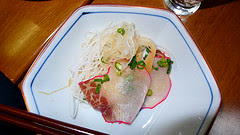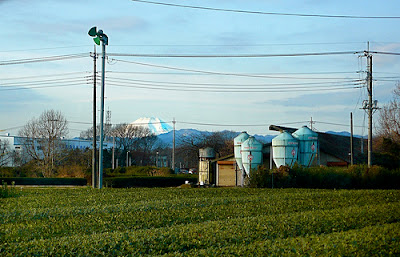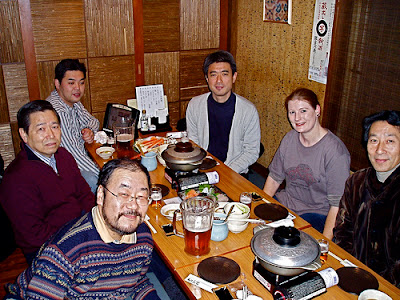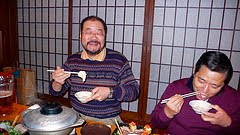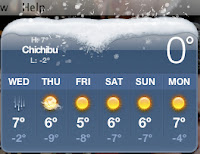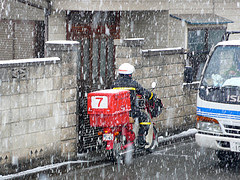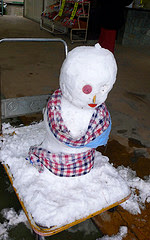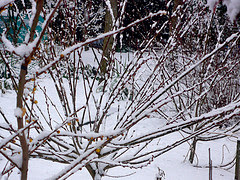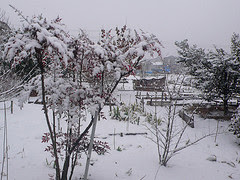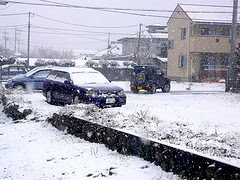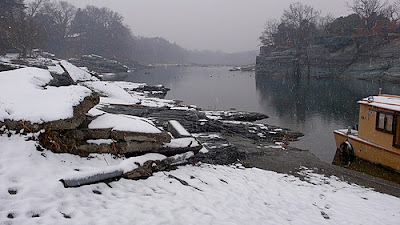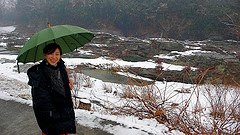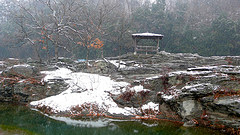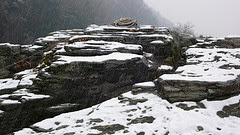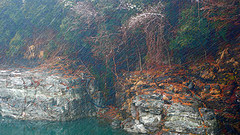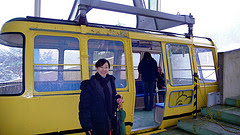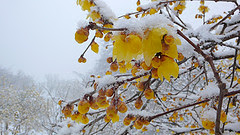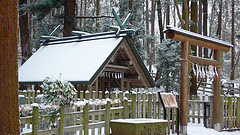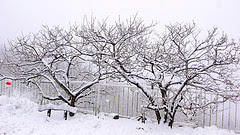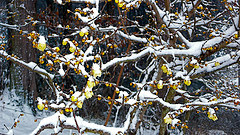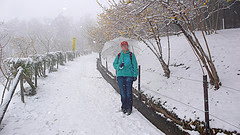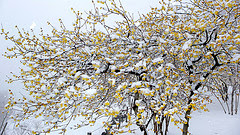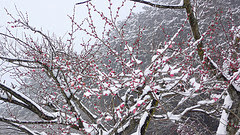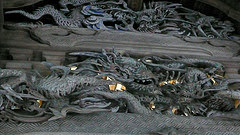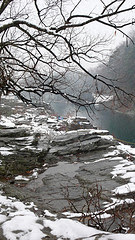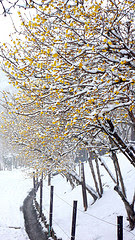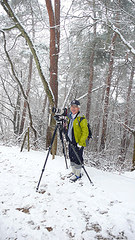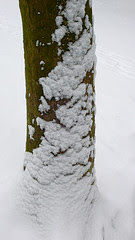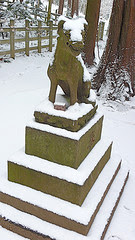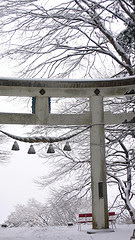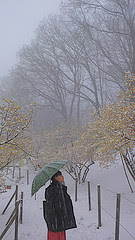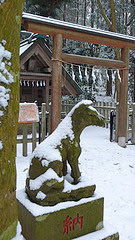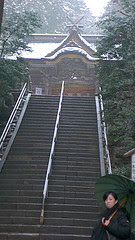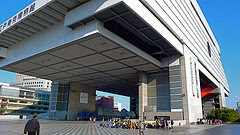
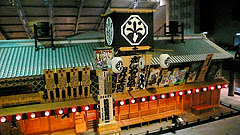
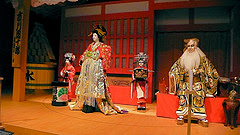
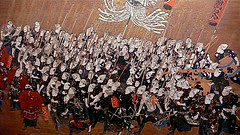
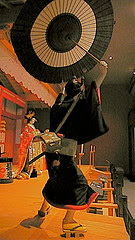
Kakizakai Sensei took me to see the Sumo in Tokyo at the Ryoguku Kokugikan across the Sumida River in Tokyo. First, we visited the Edo-Tokyo Museum of history and culture, adjacent to the Sumo stadium. The special exhibition was the Siebold and Hokusai and Their Tradition (also Hiroshige) of woodblock

printing (Japanese
ukiyo-e) and painting, including works such as Hokusai's
36 views of Mount Fuji (1826-1833) and many tremendously famous works and other panels of finely detailed ink prints, hand-coloured and paintings in the iconic style, carricature faces, curly waves,
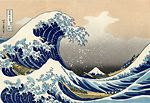
glowing mountains and elegant beauties and maidens, Hokusai's
The Great Wave off Kanagawa (神奈川沖浪裏) that is said to have inspired Debussy's
La Mer and (along with Hiroshige) influenced directly paintings by Van Gogh. The Edo-Tokyo Museum is renowned for its strikingly outlandish architecture (reminded me of Paris with its
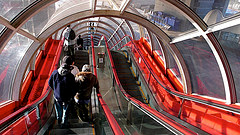
Pompidou-style escalators and monolithic proportions), housing a large-scale reconstruction of Nihonbashi bridge, a Kabuki theatre and many archaeological and historical records and remnants of the historic city, particularly as it was close to this site, traditional wooden architecture, pedestrian streets, low-rise, articles of print, swordsmanship, handcrafts, ceramics, calligraphy.
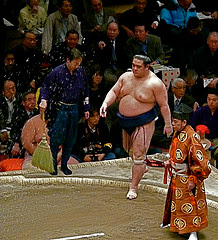
In Sumo, several aspects of the theatrics and even spiritual Shinto origins of the ring, stoicism are quintessentially Japanese. The 'ma'-like anticipation of commencing a bout, timing/knowing is remarkably like in shakuhachi playing ... an unsignalled yet 'right feeling' for timing. The same
Ryoguku site has been used for Sumo for 300 years,
Ryoguku Kokugikan (Grand Sumo Stadium). Etiquette in the Kokugikan requires that spectators do not go too near the ring because it is considered sacred, even after the last bout is over and the inherent Shinto
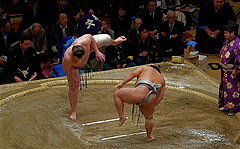
spirits and ceremonies transcend in the act of throwing purifying salt about in the ring, fastidious cleaning rituals and the respectful introduction of each wrestler, a session concluding with a bow-dance
(yumitori-shiki) with taiko drumming encouraging fans to come again. Early in the day, morning preliminary bouts of new Sumo trainees start, leading on to
Jonokuchi-Makushita (lowest rank) and
Juryo (intermediate division, at which rank and above, wrestlers are considered fully-fledged salaried Sumo professionals) and on to the senior and champion divisions that we arrived in time to watch.
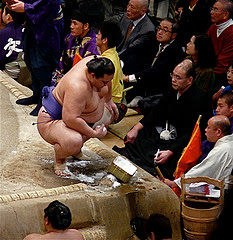
An event sheet describes the
Sumo Banzuke tournament contenders for the day representing the opposing East (Higashi) and West (Nishi) sides. A 'season' lasts 15 days and so Sensei was keen for us to reach the last days of the season before the closing weekend (already booked out). Each day escalates from mid-level (professional) wrestlers through to grand champions at the end of the day. The day preceeding, matches/clashes are decided by a committee, designating which contestants will battle whom, often fairly evenly matched though there were some surprising bouts of 'heavyweights' vs. significantly lighter wrestlers, with 40kg weight disparities, 'David and Goliath' style. While mass is an obvious advantage in this sport, the only wrestling kind to have no weight restriction, agility can also have its advantage, resulting in a few favourable outcomes. The wrestling itself was often extremely brief, longer contests drawing roars and cheers from the crowd, much of the time was devoted to ceremonious gathering of concentration, and mind-battling, like yachts jostling for a place on the starting line, the wrestlers seemingly took their position several times at the starting location before the 'ma' felt right to physically mesh. As the standard increased, so too the suspense and tension of the commencements escalated and lengthened as visual sparring and camaraderie prevailed.
The wrestlers for the
Makuuchi (Senior division) session are introduced with a ceremonial entrance and parade around the ring in traditional (expensive) aprons
(kesho-mawashi) before the afternoon matches commence, forming a circle that turns to face the crowd. This is followed by the appearance of the Yokozuna Grand Champions wearing a white rope and Shinto folded design waist-piece to much audience excitement. The ring is 4.55m in diameter, prepared by wetting down the clay and
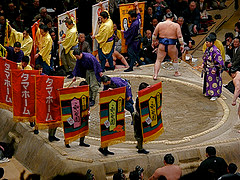
sweeping it smooth and tidying with the broom between every bout. The everyday hairstyle of the Sumo is the 'topknot' and above Juryo rank, special ginko-leaf-shaped topknots are prepared by appropriate hairdressers at the stable and firmed with oil that we smelled wafting from their hair as we followed a group of wrestlers from the train. When I asked Sensei about the status and salaries of these whale-proportioned men, he wisely replied that it was small compensation for their lack of longevity and health problems associated with strange eating and sleeping patterns practised in order to build up and maintain such mass, for a career that often ends in the 30s. Bouts between well known wrestlers attract specific bout sponsorships in which the winner also picks up the award from the sponsoring company on the banners, circulated around the ring just before the match. Signs over the central ring on the roof of the shrine-like roof, reminded us that were were fortunate to have seats in a booked-out event and we can be grateful for our chairs!
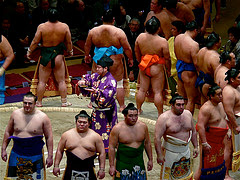

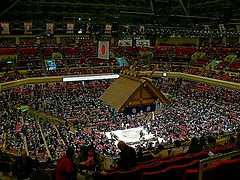

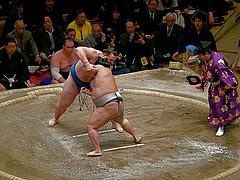
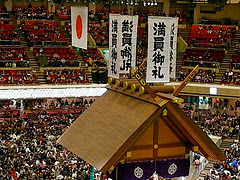



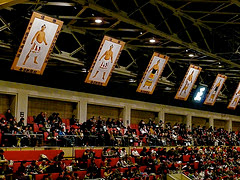
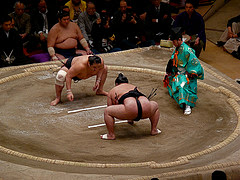
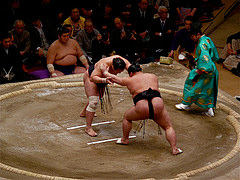
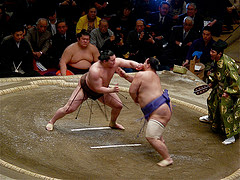
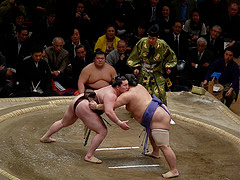
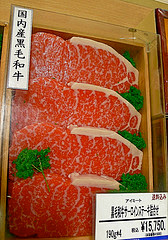

We took a quick but delicious meal of giant
gyoza (dumplings) in Ikebukuro before catching the return express train. With still a little time to spare, we visited the food hall of the Seibu Depaato (Department store). At first glance, it resembles David Jones foodhall - all gourmet delicacies and fresh produce. On closer inspection, it comes to life. Intrigues included live crabs wandering in wood-shavings, spanner crabs, strange molluscs who had larger bodies than the shell they inhabit, unspeakable large ocean mammals, inconceivably diverse sea creatures and fish bits, not to mention the $157 190g Wagyu gift-set if you would like to buy 4 steaks for your friend (who you like very much). Not a red-meat-eater? Maybe just a whole squid!
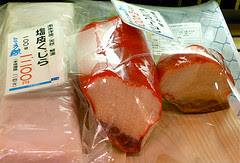
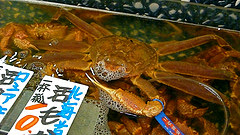
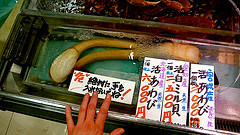
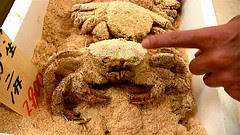
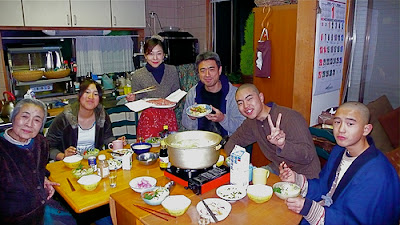
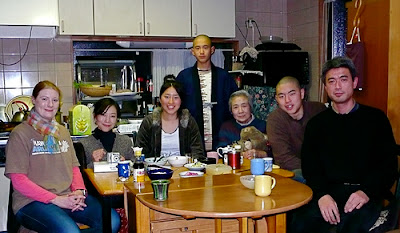 (1) Kakizakai Sensei's mother, Emi, Megumi, Sensei [wickedly holding up the last challenge in Japanese culinary delights - a deliberate test I am sure], Haruka, Takashi (2) Kirsty, Megumi, Emi, Takashi, Kakizakai Sensei's mother, Haruka, Kakizakai Sensei.
(1) Kakizakai Sensei's mother, Emi, Megumi, Sensei [wickedly holding up the last challenge in Japanese culinary delights - a deliberate test I am sure], Haruka, Takashi (2) Kirsty, Megumi, Emi, Takashi, Kakizakai Sensei's mother, Haruka, Kakizakai Sensei. Naturally, it was tinged with some regret that I had to pack up, clean out the caravan and organise to return to Australia but the Kakizakai family helped me feel very appreciative of the nice time I have had in Japan in the beautiful 'city' of Chichibu where I have made some deep friendships and had plenty of time to think, compose, practice. Their family has helped me and always made me feel very welcome and integrated. Megumi and I perhaps share an adventurous, independent spirit and enjoyed very much our excursions together and Kakizakai Sensei is so much more than my shakuhachi teacher. Many times they welcomed me to their dinner table and shared knowledge and friendship. I am glad Sensei is coming soon to Australia and wonder how next I can escape to Japan. Haruka, Emi and Takashi - Kakizakai Sensei's three hyperkinetic children - are also really cool with the stream of International visitors permeating their household. I hope they will maintain their eagerness to speak English and travel. On our final evening, Megumi prepared wonderful shabu shabu ingredients for us to collaboratively cook in a huge gas-fired urn at the table, accompanied by salads and other idiomatic dishes. Their hospitality extended to a final Shika no tone lesson on the morning of my departure, lunch and a book of photo memories summarising our time together.
Naturally, it was tinged with some regret that I had to pack up, clean out the caravan and organise to return to Australia but the Kakizakai family helped me feel very appreciative of the nice time I have had in Japan in the beautiful 'city' of Chichibu where I have made some deep friendships and had plenty of time to think, compose, practice. Their family has helped me and always made me feel very welcome and integrated. Megumi and I perhaps share an adventurous, independent spirit and enjoyed very much our excursions together and Kakizakai Sensei is so much more than my shakuhachi teacher. Many times they welcomed me to their dinner table and shared knowledge and friendship. I am glad Sensei is coming soon to Australia and wonder how next I can escape to Japan. Haruka, Emi and Takashi - Kakizakai Sensei's three hyperkinetic children - are also really cool with the stream of International visitors permeating their household. I hope they will maintain their eagerness to speak English and travel. On our final evening, Megumi prepared wonderful shabu shabu ingredients for us to collaboratively cook in a huge gas-fired urn at the table, accompanied by salads and other idiomatic dishes. Their hospitality extended to a final Shika no tone lesson on the morning of my departure, lunch and a book of photo memories summarising our time together.
